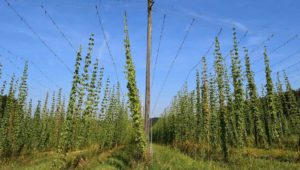 Cultivation of hops for commercial production requires a special environment. Conditions for hops growing are nowhere better than in German hop growing regions such as Hallertau, the largest contiguous hops growing area in the world.
Cultivation of hops for commercial production requires a special environment. Conditions for hops growing are nowhere better than in German hop growing regions such as Hallertau, the largest contiguous hops growing area in the world.
As hops are a climbing plant, they are trained to grow up trellises made from strings or wires that support the plants and allow them significantly greater growth with the same sunlight profile.
The hop plant’s reproduction method is that male and female flowers develop on separate plants. Because pollinated seeds are undesirable for brewing beer, only female plants are grown in hop fields, thus preventing pollination. Female plants are propagated vegetatively, and male plants are removed.
Hop plants are planted in rows about 2 to 2.5 meters apart. Each spring, the roots send forth new bines that are started up strings from the ground to an overhead trellis.
Harvest comes near the end of summer when the bines are pulled down and the flowers are taken to a hop house for drying. When dry, the hops are further processed into pellets or extract.
German grown hops are tested before they are shipped to ensure a continuous high quality. Each batch can be traced back to the producing farm. German hops are protected by the EU and are products of origin. German hops are displaying the EU quality labels PDO (Protected Designation of Origin) respectively PGI (Protected Geographical Indication) and guarantee European high quality products.
